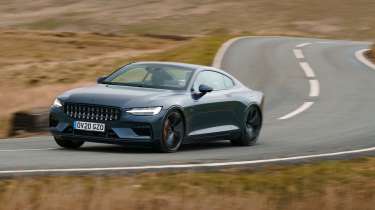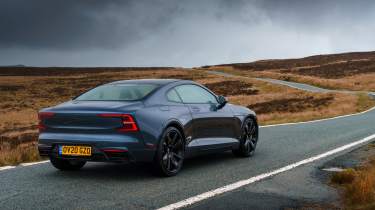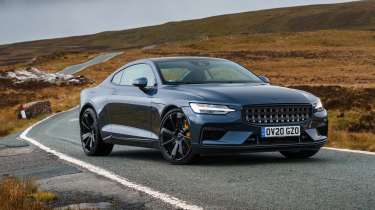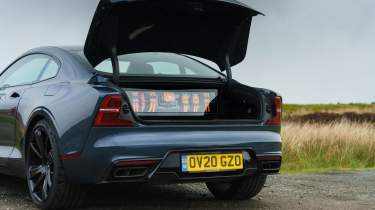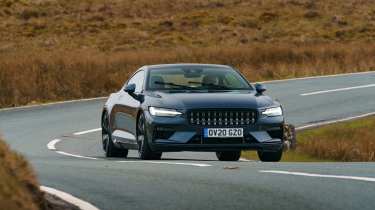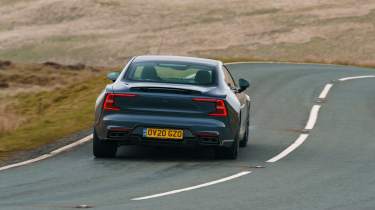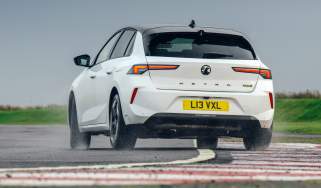Polestar 1 (2019 - 2022) – review, history and specs of a modern unicorn
One of the most appealing electrified vehicles on offer from any manufacturer, but not without its flaws
There were some in Sweden highly sceptical of Geely’s ownership of Volvo, Polestar CEO and ex-Volkswagen Group design director Thomas Ingenlath told us over dinner at the launch of the Polestar 1 in 2019.
Their anxiety was understandable. China’s industrial juggernaut was a very different beast from those in the west. It wouldn’t have been outside the realms of possibility to have stripped Volvo to the bone, consuming decades of talent, experience and innovation like a kind of automotive Dementor before moving on to other victims.
Clearly, that hasn’t happened, with Polestar developing into its own fully-fledged, handsomely funded EV brand and Volvo coming closer than ever to achieving its long-assumed premium German alternative status. The relationship has been mutually beneficial. Geely does indeed draw from Volvo’s greatest minds and talents, but in turn it has granted Volvo more creative freedom than it’s enjoyed for decades, and a large pot of money to ensure things are done properly.
Polestar 1 history
Polestar’s association with Volvo goes back further than Geely’s involvement. Its roots are in touring car racing as Flash Engineering, linked with the TWR-prepared Volvos in the BTCC, and later developing S60s and C30s for the Swedish Touring Car Championship.
The Polestar name was created in 2005, and 2010 begat the first road car, the 400bhp, all-wheel-drive C30 Polestar Concept. The first production model debuted in 2013, the six-cylinder Volvo S60 Polestar, and two years later the brand was absorbed AMG style into Volvo (the race team split to become Cyan Racing). In 2017, Volvo announced Polestar would become a dedicated manufacturer of electric vehicles.
If you’re still following, there’s another leg to the story of the car you see on these pages, the Polestar 1. In 2013, Volvo unveiled its Concept Coupe at the Frankfurt motor show. A classically elegant two-door coupe, the concept featured a 395bhp plug-in hybrid drivetrain, and was subsequently followed by the Concept Estate – a brown shooting brake, and therefore a bedroom poster car for most of the world’s automotive journalists.
We heard nothing more of the Concept Estate, but the Concept Coupe’s look and ethos carried across basically unchanged into the Polestar 1, a curious opening gambit for a company that then went into higher volumes with the Polestar 2 saloon and Polestar 3 and Polestar 4 SUVs.
It’s a fairly sizeable, three-box 2+2 coupe, with very similar styling to that of the current Volvo range. It’s quite dashing – crisp lines, perfect proportions and striking without being flashy. Colour choice can charitably be described as Scandinavian minimalism, but thankfully the car’s shape is no worse off for the whites, greys and blacks on offer.
What you can’t see is how much work has gone on under the skin. The majority of the Polestar 1’s panels are formed from carbonfibre, and it’s the first time Volvo and Polestar’s engineers have worked with the material.
Given the brand’s safety requirements, early prototypes apparently went through some amusingly destructive crash test procedures as they figured out where it should and shouldn’t be used. The lack of a structural B-pillar also caused some headaches, while early tests showed the battery packs could be problematic too, crushing everything they came into contact with.
Among Polestar’s fixes, the engineers are proudest of what they call the ‘dragonfly’. This carbon cross member sits underneath the chassis and lends it incredible strength, making the structure 60 per cent stiffer than a conventional steel platform. It also, rather cleverly, acts to transfer impact energy from the battery through to the front crash structure, in effect giving the battery packs their own crumple zone.
The end result of all this carbon is a car that not only meets Volvo’s impossibly tough safety standards, but also saves 230kg. Just as well, too. Even dripping with carbon, the Polestar 1 weighs in at 2350kg – as much as some recent all-electric SUVs. The car’s complex hybrid drivetrain is inevitably the cause.
Under the bonnet and driving the front wheels sits a 2-litre in-line four-cylinder engine, both turbocharged and supercharged. It makes 301bhp at 6000rpm, and 321lb ft of torque from 2600 to 4200rpm, and also packs a 67bhp, 119lb ft ‘integrated starter generator’ between the engine and eight-speed automatic gearbox, to assist and regenerate energy when required.
At the rear axle are a pair of 85kW electric motors, hooked to the wheels through planetary gearsets that allow for true torque vectoring – the outside wheel can rotate faster than the inside wheel through a corner. Combined, they deliver 229bhp and 354lb ft. Volvo quotes an overall combined output of 592bhp and 737lb ft – the latter a nice, round 1000 newton-metres.
It’s good for 0-62mph in 4.2sec, and 155mph flat out, with up to 100mph possible on electric power alone. There’s also enough juice in the 34kWh battery pack for a claimed 93 miles in Pure mode, with a further 300 or so possible on the car’s 60-litre tank.
The biggest compromise of the car’s hybrid set-up isn’t range then, or even weight, but space. Front-seat passengers will have little to complain about, even if the dashboard architecture has changed little from that of the pleasant but workday S60, but the rear seats are child-sized only, and the boot is largely occupied by the battery and its attendant electronics.
If there’s a saving grace to the 143-litre cubby, it’s that rather than staring at a wall of carpet, Polestar has chosen to show off the car’s power electronics, with a clear panel over the various orange cables, each annotated with its purpose. Not as glorious as staring down upon a V12 in a mid-engined supercar perhaps, but existing hybrids and EVs have so far offered little for our inner engineers to get excited about, so hopefully others take Polestar’s lead on putting the inner workings front and centre.
There are other surprise and delight features too. Each car features graphics on its front wings denoting its carbon construction, and there’s a similar decal on a slim carbon trim piece in each door sill opening, which makes each car feel a little like a skunkworks factory prototype. While the cabin design is staid, the materials and comfort factor make up for it, and the frameless door windows give the cabin an airy, pillarless feel.
Starting is as drama-free and silent as in any other electric vehicle, and the curious pleasure of pulling away in total silence still never gets old. The Polestar 1 feels substantial, but responsive electric power and excellent visibility make navigating Florentine traffic less stressful than it might be.
The first few miles are driven in Hybrid mode, with the crystalline transmission lever bumped into ‘B’, which increases the regenerative braking effect. In this mode the car operates predominantly on electric power, and therefore using the rear wheels alone, and the recuperation effect is strong enough that you can drive more or less with one pedal. A squeeze of the brakes is required to pull to a halt, but with forward planning you need rarely touch the brakes.
As the road begins to twist, it’s time to try the car’s performance mode. Here, the engine fires up to assist the electric motors, the braking regen backs off, and you have the full 592bhp and 737lb ft to call upon, as well as sharper responses to the throttle and a touch more heft to the steering.
Acceleration is quite remarkable. Response is effectively instant, thanks to the twin motors, and they effectively negate whatever time it takes the engine to wake up and deliver its best. With everything working at full potential, the surge is relentless, accompanied by a menagerie of automotive noises, from turbo whoosh and supercharger whine to the whirr of electric motors and a curious flat-four-like throb from Volvo’s usually dreary four-cylinder.
There is, uniquely in a car like this, even a tug of torque-steer through the wheel as the 275-section tyres (295s at the rear) claw at the greasy surface, but it’s more prominent in a straight line than it is in corners. With some cornering attitude, the car just seems to hook up and slingshot down the following straight, torque vectoring keeping the nose tight in a way that recalls four-wheel steering.
There’s not a great deal of steering feedback, but with so much grip and so many electric forces at work, it becomes easy to trust that the car will follow your inputs. The massive 400mm Akebono front brakes are even easier to trust. While slightly abrupt at faster velocities, they shed speed like the 1 is half its 2.3-ton mass.
The Polestar 1’s actually more prone to misbehaviour in regular old Hybrid mode. With more than half the car’s torque delivered to the back wheels alone, they break traction with little encouragement and little warning if the surface is damp. The stability control quickly reins things in, but with more than two tons suddenly on the move (and no audible flare of revs as a warning shot) it still needs quick reactions on the steering.
The biggest blot on the 1’s copybook though is ride quality. Like with previous the Polestars that preceded it, the engineers chose manually adjustable Öhlins dampers, but as tested the set-up led to some quite abrupt movements over bumps, out of character with the smooth powertrain and cosseting cabin. A few twists might fix that, though the trade-off might be a little less of the 1’s impressive body control.
Polestar’s decision to offer left-hand drive only on its first model will have alienated a few interested parties but it was the price that proved to be the Polestar 1's biggest hurdle. From £139,000 new, it was a properly difficult sell for what was an all but unknown brand at the time. It was the definition of an acquired taste in a competitive market when new and now, is perhaps one of the ultimate unicorns.
Price, rivals and specs
No, the Polestar 1’s technology and performance didn't come cheap – UK pricing is quoted at £139,000, but when you add up the carbon technology, the hybrid drivetrain and high-end components, it’s also easy to see where the money went
As such an unusual proposition it was difficult to pick any one car as a direct rival for the Polestar 1 but it wasn't alone in the run up to 2020, in high-tech inicorndom. Rhe BMW i8 and Honda NSX are both outlier techfests that take a different approach to established rivals, though each car is very different in character. Given the GT billing and its silhouette, you could maybe compare it to the BMW M8, too.
| Engine | In-line 4-cyl, 1969cc, 3x electric motors |
|---|---|
| Power | 592bhp |
| Torque | 737lb ft |
| Weight | 2350kg |
| 0-62mph | 4.2sec |
| Top speed | 155mph (limited) |
| Price (when new) | £139,000 |

